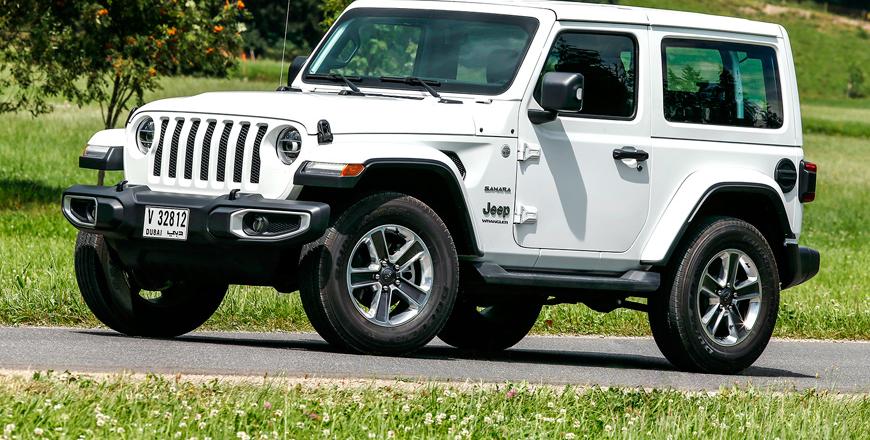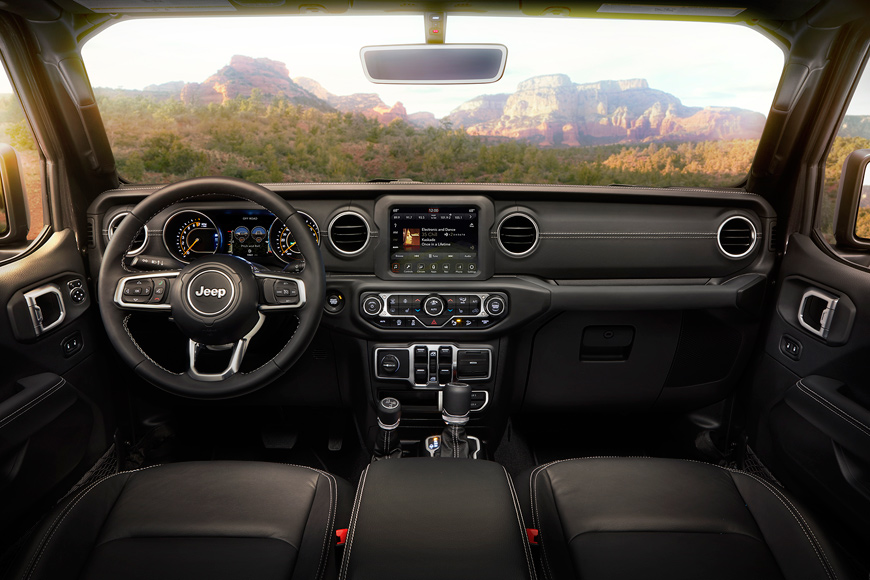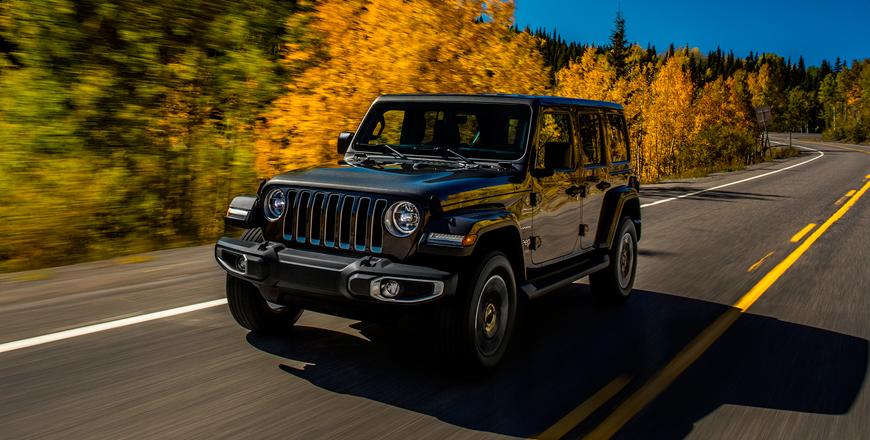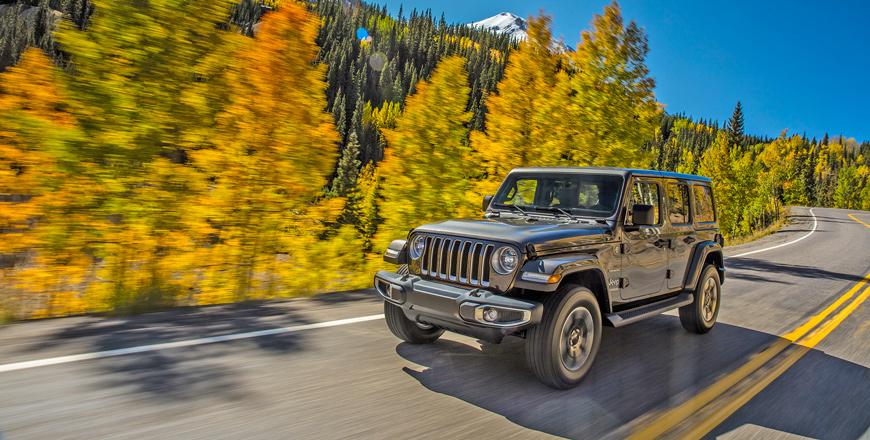You are here
Jeep Wrangler Sahara 2-Door: Rugged yet refined
By Ghaith Madadha - Jun 28,2021 - Last updated at Jun 28,2021

Photos courtesy of Jeep
A direct descendent of the celebrated and viscerally iconic 1941 Willys Jeep, the latest “JL” generation Jeep Wrangler is steeped in tradition, authenticity and genuine off-road ability that it has earned over several generations, and maintains in both its design aesthetic and engineering architecture.
That said, it is the most sophisticated and refined Wrangler to date, with better convenience, safety, technology practicality and efficiency than ever, with the most civilised, well-equipped and luxurious daily driver being the Sahara specification version.
Hallmarks and hark backs
Launched in 2018 as a design evolution of its immediate predecessor, the “JL” Wrangler was first available in basic Sport, off-road oriented Rubicon and more luxurious Sahara specification in either 2-door personal luxury or 4-door family-friendly body styles. Conceding slightly more swept back windshield and grille angles for aerodynamic efficiency, the “JL” is instantly recognisable as a Jeep, and also harks back to the 1944-86 “CJ” generation Jeep with its round lights intruding slightly into the outer grille slots.
Best proportioned and most evocative in 2-door guise, the “JL” Wrangler is true to its hallmark design cues from its boxy shape, tapered bonnet, seven slot grille upright design, and large wheel-arches, the latter of which are finished in body colour for Sahara models. A slightly larger but lighter vehicle than its predecessor owing to greater aluminium content, the “JL” is still built on a rugged body-on-chassis frame, with integrated rollover bars, short front overhang, rearwards cabin position and short wheelbase.

Confident and capable
Sold exclusively with a combination of naturally-aspirated 3.6-litre “Pentastar” V6 engine and slick, smooth and quick shifting 8-speed automatic gearbox in the Middle East, the Wrangler Sahara produces 281BHP at a peaky 6400rpm and 256lb/ft torque at 4100rpm. Responsive from standstill, and flexible in mid-range with a generous portion of torque accessible over a broad range, the Wrangler is eager revving to its top-end, and seamlessly progressive in delivery. Briskly motivating its 1.9-tonnes through 0-100km/h, the Wrangler can achieve 177km/h.
Responsive, accurate and progressive, the Wrangler’s V6 allows one to dial in fine-tuned power increments, whether through on-road corners or for delicate off-road maneuvers. Thoroughly capable off-road, the Sahara’s Selec-Trac system allows for on-the-move shifting between rear-wheel-drive and four-wheel-drive at up to 72km/h, and includes a 4WD “auto” mode, where power is allocated from rear to front as needed for efficiency and traction. For more demanding low traction, steep inclines and other off-road conditions, the Sahara features low ratio four-wheel-drive.
Accomplished architecture
A natural off-roader with rugged ladder frame construction with both front and rear coil sprung solid axles for excellent axle articulation, the Wrangler might not be as refined on-road as other independent suspension Jeeps, but is a superior off-roader, and drives with a significantly higher level of refinement on-road than expected of such traditional architecture. Meanwhile, its low gear ratios allow it to drive at full power at a crawling pace over deep ruts and other inhospitable conditions.
The more civilised of Wranglers, the Sahara receives slightly lower profile tyres for improved road dynamics, but at 255/70R18 are still very capable off-road. Its short overhangs and high 235mm ground clearance meanwhile allow for generous 37.4° approach, 26.2° break-over and 30.5° departure angles, and its upright body and big glasshouse provide good visibility. Highly accomplished on dirt roads or far more demanding conditions, the Sahara, however, does not receive the more hardcore Rubicon version’s locking rear, centre and front differentials.

Up-market utility
Highly manoeuvrable on narrow lanes and tracks with a tight turning circle, the shorter wheelbase two-door Wrangler meanwhile turns tidily into, and is agile through, corners, despite a tall steering ratio, and is available with an optional limited slip differential to prevent wheelspin and maintain traction. Comfortable over rough imperfections with its tall tyres and multilink coil sprung solid axles, the Wrangler remains settled and buttoned down on rebound and is stable at speed for such a decidedly off-road-oriented vehicle.
Matching its enhanced and better than expected refinement, the Wrangler Sahara receives a more up-market cabin treatment, using higher quality trim, upholstery and materials. Well-accommodating four passengers in a compact frame, the 2-door Sahara comes with extensive convenience, safety and driver assistance features, including Uconnect infotainment and blind spot and rear cross-path detection systems. Offered with a choice of three detachable soft and hard tops, removable doors and fold-down windscreen, the Wrangler meanwhile delivers a true open air outdoor driving experience.
TECHNICAL SPECIFICATIONS
Engine: 3.6-litre, in-line, V6-cylinders
Bore x Stroke: 96 x 83mm
Compression ratio: 11.3:1
Valve-train: DOHC, 24-valve, variable timing
Gearbox: 8-speed automatic, four-wheel-drive, low ratio transfer
Gear ratios: 1st 4.71:1; 2nd 3.13:1; 3rd 2.10:1; 4th 1.67:1; 5th 1.28:1; 6th 1.00:1; 7th 0.84:1; 8th 0.67:1
Reverse/final drive: 3.29:1 /3.45:1
Low ratio transfer: 2.72:1
Power, BHP (PS) [kW]: 281 (285) [209] @6,400rpm
Specific power: 77.9BHP/litre
Torque, lb/ft (Nm): 256 (347) @4,100rpm
Specific torque: 96.2Nm/litre
Top speed: 177km/h
Fuel consumption, urban/extra-urban/combined; 13-/7.7-/
9.6-litres/100km
CO2 emissions, combined: 223g/km
Fuel capacity: 66-liters
Length: 4,334mm
Width: 1,894mm
Height: 1,878mm
Wheelbase: 2,459mm
Track: 1598mm
Overhang, F/R: 741/1,036
Ground clearance: 235mm
Approach/break-over/departure angles: 37.4°/26.2°/30.5°
Water fording: 760mm
Seating: 4
Loading height: 762mm
Cargo volume min/max: 203-/598-litres
Kerb weight: approximately 1,900kg
Weight distribution, F/R; 51 per cent/49 per cent
Payload: 483kg
Steering: Power-assisted rack & pinion
Steering ratio: 16.14:1
Lock-to-lock: 3.68-turns
Turning circle: 10.36-metres
Suspension: Solid axles, coil springs, anti-roll bars
Brakes, F/R: Ventilated disc, 330 x 28mm/disc, 342 x 14mm
Brake calipers, F/R: twin-/single-piston
Tyres: 255/70R18
Related Articles
Launched in 2018, the current “JL” generation of Jeep’s defining Wrangler model remains one of the most capable off-road vehicles to be foun
The range-topping and off-road oriented version of what is already one of the best off-road vehicles money can buy, the Jeep Wrangler Rubico
The more sociable version of the Jeep Wrangler, the longer four-door model is a more spacious and family-friendly way to enjoy the most icon


















